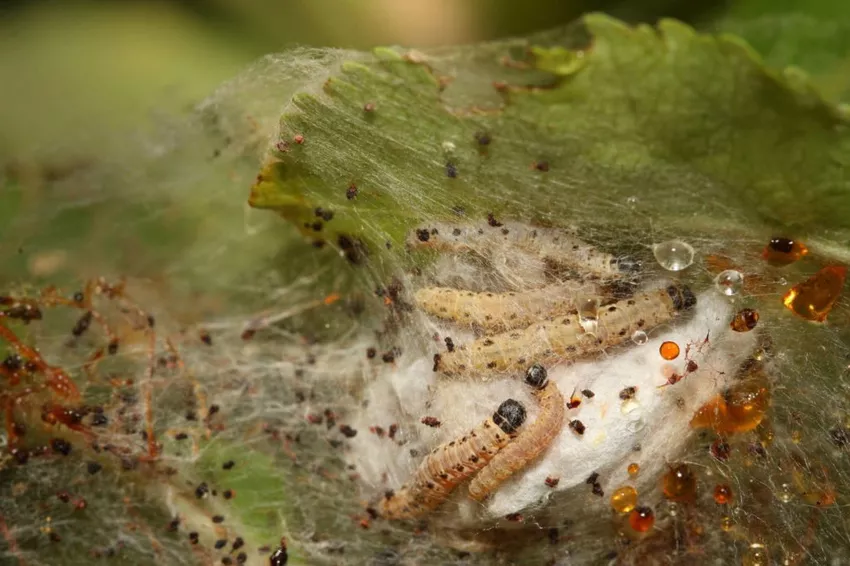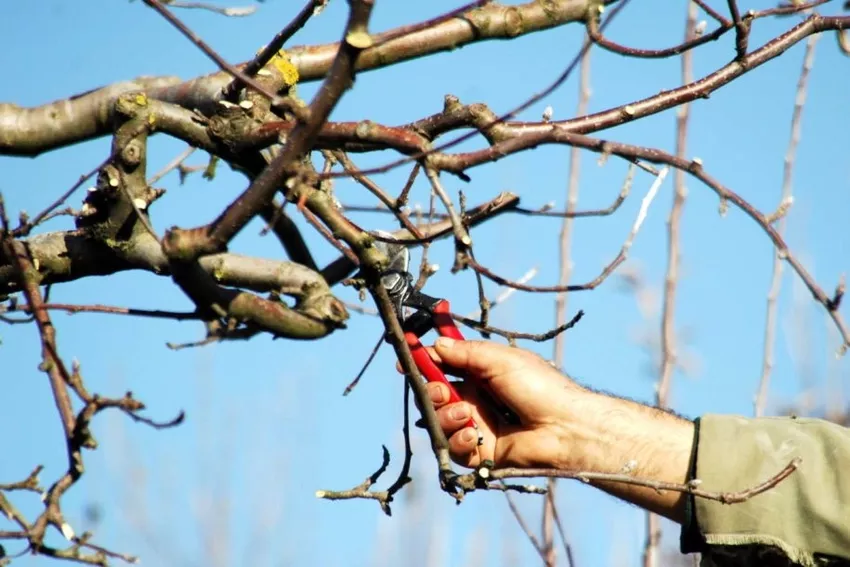In spring it can happen that the apple tree lays itself in a white net as if by magic. The apple spider moth is responsible for this.

The larvae of the apple spider moth (Yponomeuta malinellus) can wrap our trees in webs and eat their fill of the leaves. In the following section we will explain how you can recognize this pest. We also tell you what you can do against these moths.
Apple spider moth: profile and life cycle
The apple spider moth or apple tree spider moth belongs to the spider and bud moth family (Yponomeutidae) and produces only one generation per year.
The moths hatch in summer, between June and August. After the females have mated, they lay their eggs in an imbricated pattern under a layer of secretion on the bark of the apple trees to protect them. The secretion layer then hardens. This oviposition occurs from mid-July to August of the previous year.
The eggs have a yellowish color at first and are elongated oval. After some time the eggs turn brown and after a few weeks the larvae hatch from them. They hibernate under the secretion layer and do not eat at first.
In the spring from the beginning of May the caterpillars start feeding on the leaves or they mine in them. The formation of the webs in which they live together as a community soon begins thereafter. In June, the larvae pupate in the web and white, solid cocoons develop, which can then be seen in the web. The adult moths then hatch from these cocoons.

Mild winters with little snow are favorable for the spider moths, because then the survival rate of the larvae is highest. In order for the moths to mate, the temperature at night (between 1 a.m. and 4 a.m.) must be above 12 °C. It is therefore also understandable that there are particularly many offspring in hot and dry summers, but if it rains a lot, this has a negative effect on the reproduction of the spider moths.
Recognize Apple Spider Moth
Theadult moths have a wingspan of 16 to 23 mm. Like all moths of the family Yponomeutidae, their fringed forewings are white with black spots and the hindwings are grey. When the moths are at rest, they fold their wings in a roof shape.

The larvae, on the other hand, have a yellowish to greenish color, but also have black spots and few hairs. Their head capsule and legs are dark in color. The larvae of the apple spider moth can reach a size of 18 to 25 mm.

Apple spider moth: How dangerous for the apple tree?
In principle, the infestation is not fatal for your apple tree. Even if there is a heavy infestation, the tree can usually sprout again, even after the larvae have defoliated it. Of course, this has a strong influence on the yield and you can expect a lower yield in the following year.
The infestation with the spider moths is primarily an optical problem. Finally, the ornamental value is greatly reduced if you have an apple tree in your garden that looks like it was wrapped in a hair net.
You can recognize the infestation from April (i.e. shortly or during flowering), when the leaf tips or other leaf parts change color and turn brown. These areas then also dry up and when you open them, small caterpillars can be found. From May you can see the white webs that suddenly appear on the side and end shoots. A closer look reveals the larvae of the apple spider moth.

In the event of an extreme infestation, the whole tree may be bare - but don't worry, the tree can sprout again. However, if there is a massive infestation, the larvae may search for new food sources, climb down the trunk and then infest other host plants as well.
A (perennial) infestation can certainly weaken the tree and, as already mentioned, yield losses can occur in the following years.
Successfully combat apple spider moth
We all know that the cobwebs don't make a pretty picture in our gardens. But do these small moths really cause problems for our trees or is it just an optical problem that we are addressing herefight?
Do we have to fight the apple spider moth?
In general, you don't have to worry about your apple tree being infested. Of course, these webs do not make a pretty picture, but they are not dangerous. If you still want to get rid of the moths, we'll explain how to do that in the following section.
Biological control of apple spider moth
The easiest way to get rid of apple spider moths is to collect them. Remove webs with a broom or hose them down with a hard jet of water. It is important to collect the remains of webs and larvae on the ground so that they cannot migrate back up the tree. To make it easier to collect, you can put a cloth under the tree before you get started. This allows you to quickly collect and dispose of falling larvae. You can of course also cut out the webs if there are not too many. Dispose of these leftovers in the garbage and not in the compost.
To prevent the larvae from rising from the ground, you can attach glue rings to your tree trunks. The fallen larvae then stick to the glue when they want to climb up the tree again.

There are also beneficial insects that can be used against the spider moths, but these are usually only used in the case of heavy infestations in fruit growing. Parasitic wasps (lchneumonidae) and chalcid wasps (Chalcidoidea) can help with spider moths. These beneficial insects are among the natural antagonists of spider moths.

Pheromones are also a remedy that can be used against the spider moths. There are special traps that emit pheromones for the apple spider moths and thus attract the moths. The trap contains glued surfaces to which the moths then stick. This can prevent mating and reduce egg laying. When it comes to pheromone traps, it is particularly important to use the right ones. Pheromones are very species specific. Therefore, for example, traps against the codling moth have no effect on the spider moths and vice versa.

Biological control of apple spider moths with XenTari®
XenTari® is a natural insecticide and is used on public green spaces, orchards and in organic farmingsuccessfully used and combats the apple spider moth without chemicals. The agent works in a biological way against free-eating butterfly caterpillars, i.e. caterpillars that do not live in the plant. Other groups of insects are not harmed: the active ingredient has no effect on wild and honey bees, beneficial insects or arachnids. This special feature is possible thanks to the active ingredient it contains: surviving spores of the bacterium Bacillus thuringiensis (Bt), which is a frequently occurring organism in soil. Bacillus thuringiensis is ingested by the larvae with their food and is converted into a poison during digestion. This causes the larvae to stop eating and eventually die from a kind of "blood poisoning". Bacillus thuringiensis only records early larval stages, the remedy should be used from mid-April to around mid-May. It is also important to use other remedies before the formation of webs - later use has no effect.
Chemical control of apple spider moth
Nitroguanidines or neonicotinoids are currently the newest and best-selling group of insecticides worldwide. Their active ingredient such as thiacloprid also shows an effect. Products are very well tolerated by plants, can be mixed without any problems and can be used in a wide range of temperatures. The biggest disadvantage of this is clearly the toxicity to honey bees, wild bees, bumblebees and other pollinating insects. For example, negative effects on the orientation ability of honey bees have been proven, which is why the use of this neurotoxin has been severely restricted in recent years.
Apple Spider Moth: successfully prevent infestation
If you have already had an infestation, it is advisable to cut back and maintain it, especially in winter. You should check the cutting waste, because this is where the eggs or the hibernating larvae can be found. Do not put the branches you cut off in the compost, but dispose of them at the waste disposal site. Here you will learn from the experts how to properly prune your apple tree.

Glue rings show no preventive effect on the apple spider moth, since the clutches are then already on the branches of the tree. The glue rings can only prevent the larvae from climbing again if you remove the webs mechanically in summer.
Caring for an apple tree isn't just about fighting the spider moth. Tips for care and many moreSee our apple tree article for info.